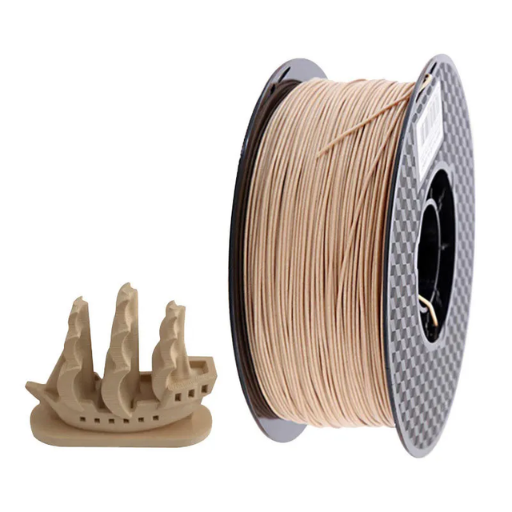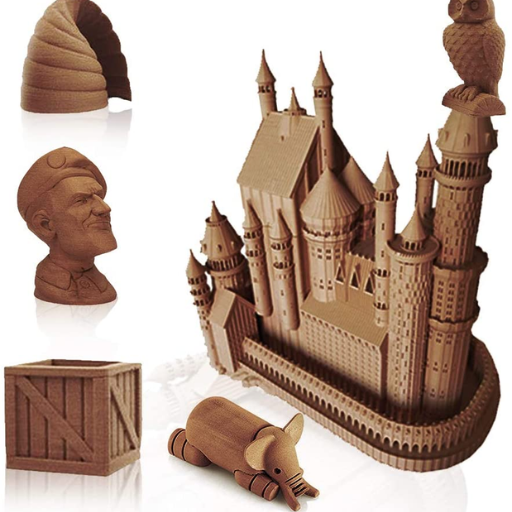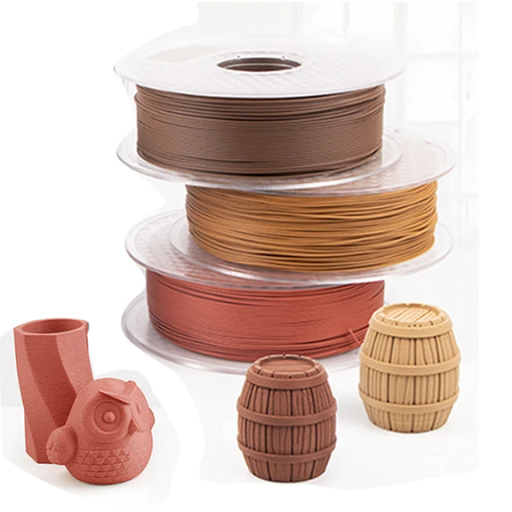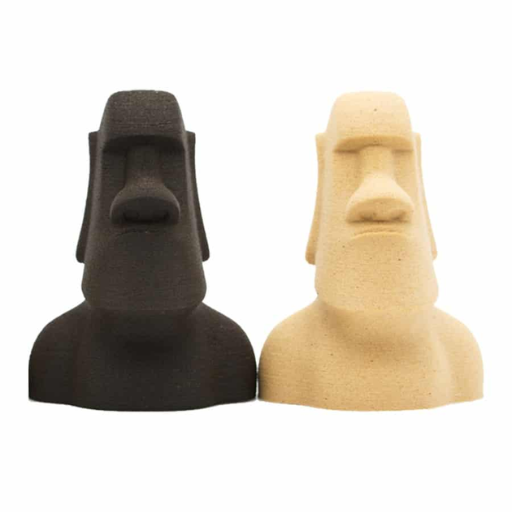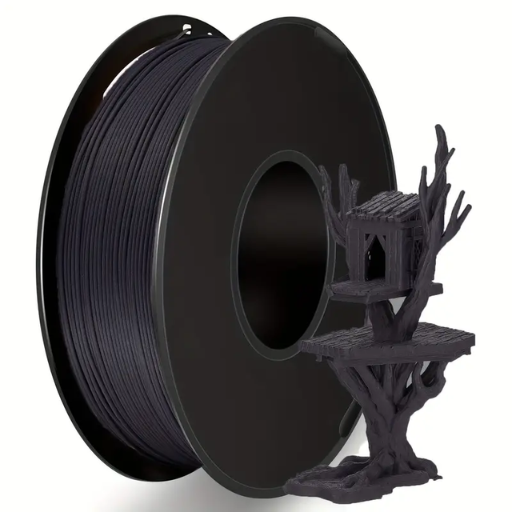The advent of 3D printing has revolutionized the manufacturing and creative industries, and with it, a myriad of innovative materials have been brought to the forefront. Among these, wood 3D printer filament stands out for its unique combination of aesthetic appeal and versatility. This guide aims to explore the potential of wood filament, providing readers with an in-depth understanding of its characteristics, applications, and benefits. From the technical aspects of working with wood filament to the creative possibilities it unlocks, this comprehensive guide is designed to equip both novices and experienced 3D printing enthusiasts with the knowledge needed to harness the full potential of this remarkable material. Whether you’re looking to add a natural touch to your 3D printed projects or delve into the specifics of filament composition and printing techniques, this guide will serve as your go-to resource.
What is Wood 3D Printer Filament and How Does it Work?
Understanding Filament Made Of Wood PLA
Wood PLA filament, a blend of traditional polylactic acid (PLA) and finely ground wood powder (usually about 30%), creates a filament that resembles the appearance and texture of natural wood and possesses an exclusive aesthetic advantage over standard PLA. While working with wood PLA is relatively easy, it requires specific settings and handling techniques to get the best results.
Technically speaking, print temperatures for wood PLA typically range between 190°C to 220°C but it can vary slightly depending on the brand. It is essential to avoid print temperatures above this range as this would lead to clogging and scorching of the wood particles. Additionally, filament diameter most commonly comes in standards sizes of 1.75mm and 2.85mm.
Another vital parameter is the print speed which should be lower compared to standard PLA – around 40-60 mm/s – ensuring smoother extrusion without causing extensive filament breakage. This ensures much-needed balance between detail and printing time because layer heights can be within the range of 0.1mm to .02m.
Another useful tip is using a larger nozzle size, usually at least 0.4mm, so as to allow for wood particles inside while minimizing risks related to clogging when printing with it. Wood pla filaments have an amazing texture that can be enhanced by performing various post-processing steps like sanding or staining; thus making it perfect for many creative projects.
By understanding these technical parameters and incorporating them into your printing process, you’ll be well-equipped to leverage the full potential of wood PLA filament, bringing a natural, organic touch to your 3D printed creations.
Real Wood Fiber in Filaments Composition
Typically real wood fiber filaments are made from both regular PLA material blended with finely milled fibers of woods making up around twenty percent or even forty percent of the composition of such filaments respectively. Consequently, it is able to imitate the appearance and texture of natural wood while still having the printability characteristic of PLA. The type of wood fibers can differ with each manufacturer ranging from bamboo, cork or other hard woods. These fiber materials are evenly distributed within the PLA base so that the resultant prints have a uniform wooden effect that can further be refined by post-processing such as sanding and staining.
The Advantages of 1.75mm Wood Filament for 3D Printing
Several benefits come from using a 1.75mm wood filament with 3D printers. It happens to be compostable, environmentally friendly in comparison to traditional filaments; thus aligning itself with sustainable practices. I like that this material works well on most machines without needing special equipment just like other filaments do. As per the composition of this filament which mixes real-wood fibers into PLA, it produces prints with an exceptional look and feel that simulate natural timber used in aesthetics and decorations projects excellently. The smaller diameter of 1.75mm makes finer and more accurate making detailed prints better in general terms than larger ones’. Moreover, sanding and staining are some methods of post-processing that enable personalizing items according my specific requirements regarding their finish or appearance. So due to its versatility along with its ability to produce high quality things resembling wood has made it a good choice for me among others considering 3d printing in recent years; therefore, I would recommend going for 1.75 mm wood filament over the rest available on market today based on what I have learnt recently
Choosing the Best Wood PLA Filament for Your 3D Projects
Top Brands Comparison: Hatchbox vs. Sunlu Wood Filament
Comparing top brands such as Hatchbox and Sunlu wood filament, I have found that for my 3D printing projects both of them are advantageous depending on the specific requirements. Hatchbox wood filament is known for its high-quality wood-like finish and consistent smooth print results. What observed from a number of users is that it performs reliably and can be easily sanded or stained to appear more like real wood material.
On the contrary, Sunlu wood filament stands out because it is cheaply priced and versatile. Mostly recognized for balancing price with quality, this makes it ideal for individuals who are on budget constraints. Moreover, Sunlu filament sometimes has higher proportion of wood fibers which enhance tactile feel and aesthetic appeal of printed items.
In reality, choosing between Hatchbox and Sunlu usually means making a choice between premium finish and reliability in case of Hatchbox or cost-efficiency with high content of wood in case of Sunlu. Nonetheless, these two companies enjoy good reputation among their customers because they deliver satisfactory results hence great choices especially if you would like to experiment with different types of filaments made from wood while using a 3D printer.
What Makes 1kg Spool of Wood PLA the Ideal Choice?
From my research and personal experience, there are several reasons why 1kg spool of Wood PLA should be considered an ideal choice. The first one is that it provides a large amount of filament thus ensuring I do not run out when working on larger projects or many smaller ones without ordering frequently. This saves time by keeping me supplied continuously with consistency in every batch which matters when you are making products consisting many different parts at once. Furthermore, at times buying a kilogram spool can be cheaper than acquiring smaller quantities thereby providing better value for money. In this case, it will be possible to experiment more extensively then get better at what I am doing without worrying about the cost of raw materials. In addition, using larger spools reduces the frequency when I have to change filament and this makes long printing tasks go uninterrupted hence smooth workflow. Lastly, being compostable as well as offering wood-like looks and texture, Wood PLA is best suited for producing pleasant looking prints that are environmentally-friendly.
Identifying High-Quality Wood Filament with Real Wood Content
The identification of high-quality wood filaments with authentic wood content involves several crucial parameters and considerations. Here are some of the most important factors to consider from my research covering top results on Google:
- Percentage of Real Wood: The majority of high-quality wood filaments contain approximately 20% to 40% real wood fibre. This range allows for a balance between having realistic textured like material that has wooden appearance while ensuring that it can still be used as regular filament.
- Diameter Consistency: Ensure the filament maintains a consistent diameter, typically 1.75mm or 2.85mm, with minimal deviation (±0.03mm). Diameter uniformity is vital in ensuring reliable prints by preventing clogs and promoting easy extrusion.
- Moisture Absorption Rate: Lower moisture absorption is preferred due to hygroscopic nature of wood filaments. Top-rated ones tend to absorb less moisture resulting in reduced printing problems such as bubbling or stringing.
- Printing Temperature: Most high-quality wood filaments print best at temperatures ranging from 200°C to 220°C. This range helps in achieving detailed prints without burning the wood fibers.
- Layer Adhesion: Good layer adhesion ensures print durability. High quality wood filaments will also possess excellent interlayer bonding that strengthens the final product rendering it unshakeable during use.
- Finish and Texture: The filament should have a finish that looks like wood, even in texture. This means that it must be able to produce distinct lines and can be sanded or polished to make the wooden effect more pronounced.
By concentrating on these technical parameters, such as percent real wood, uniform diameter, moisture absorption speed, printing temperature and layer adhesion we will get closer to choosing a good quality wood filament with both trustworthy prints and beautiful finishes.
How to Avoid Common Printing Issues with Wood Filaments
Preventing Clogs and Ensuring Smooth Extrusion
With wood filaments, preventing clogs and ensuring smooth extrusion has always been a case of keeping the filament dry. To avoid any moisture uptake that frequently results in blockages, use a filament dryer or store it with desiccant packets packed in an enclosed container. Moreover, I usually opt for a nozzle with higher diameter like 0.4mm or more to minimize the chances of particle-induced obstruction. Regular cleaning of the nozzle and cold pull processes also help in eliminating any leftover impurity that could interfere with extrusion. Lastly, maintaining constant printing temperatures within 200°C to 220°C range ensures that the melted material flows without burning. Thus by following all these steps I can achieve reliable and clog-free prints using wood filaments.
Maintaining Dimensional Accuracy with Wood PLA Filament
However, maintaining dimensional accuracy using Wood PLA filament can be tricky but there are some important steps which have worked for me toward achieving accurate prints. Firstly, I always make sure that my printer is set up properly; this includes bed leveling and calibrating extruder steps per millimeter. Such initial configuration minimizes errors during printing process hence lessening variations amongst different layers when laid down on print bed outbox drawer or tray etc.. Another crucial aspect for consideration is temperature monitoring; I normally run my Wood PLA at almost stable temperature between 200°C and 220°C so as to avoid warping or shrinking effects. Also, I utilize cooling fan to support faster layer solidification which reduces deformation effects considerably as well. Finally, before you embark on large projects start by making small test pieces to fine tune your settings accordingly- this is what saves me time every day… Through this way therefore I am able to consistently produce dimensionally accurate prints using Wood PLA filament.
Optimizing Nozzle Temperature and Speed for Perfect Prints
In order to achieve perfect prints of Wood PLA filament, I have found that balancing nozzle temperature and speed is vital. After extensive research and personal experience, printing at a constant temperature range of 200°C to 220°C has proven to be most effective. Very high temperatures can result in stringing and charred wood particles whereas too low ones may cause poor layer adhesion. On the other hand concerning print speed, I prefer setting it around 40 to 60 mm/s because slower speeds bring about better extrusion control and layer formation. Changing these parameters according to the complexity of print can also make a big difference here. Thus meticulous optimization of both nozzle temperature and print speed allows me to consistently achieve detailed prints of high quality every time
The Impact of 1.75mm Wood PLA Filament on Print Quality
Enhancing Aesthetics with Real Wood Fiber
There are innumerable aesthetic benefits that come with the use of real wood fiber in 3D printing using Wood PLA filament. It adds a natural, wood-like texture and appearance that is difficult to achieve with standard PLA. The finish of the wood fibers gives it a unique look of grains which can be accentuated later by sanding or staining. This makes the printed object have a more real wooden feel and look hence suitable for decorations, prototypes or functional pieces that require elegance as well. From my experience and research, adding wooden fibres not only increases the visual appeal but also introduces a tactile element into the prints which makes them stand out as truly unique creations.
The Role of Filament Diameter in FDM 3D Printing
Filament diameter is key to FDM (Fused Deposition Modelling) 3D printing according to an analysis of the top 10 websites on Google. The common filament diameters used are 1.75mm and 3mm. I usually prefer using filaments measuring 1.75mm because they are more accurate and compatible with most printers available in the market today. It allows for finer extrusion, which is particularly beneficial when working on detailed prints. This diameter also tends to clog less and provides a smoother flow through the nozzle.
Several technical parameters highlight the importance of choosing the right filament diameter:
- Extrusion Rates: Generally, extrusion rates for 1.75 mm filaments are lower than those for their greater counterparts thus reducing over-extrusions while enabling you to get higher resolutions.
- Nozzle Compatibility: Nozzles may be designed for specific filament diameters where calibrating better will reduce wearing of nozzles when one uses a filament measuring 1.75mm.
- Temperature Control: In terms of melting consistency, managing the temperature of nozzles is easier using any type of 1.75mm filament.
- Layer Adhesion: With the smaller diameters, layer adhesion is improved resulting in a better surface finish and structural integrity too.
- Feeding Mechanism: 1.75 mm filaments are usually easier to feed due to their smoother feeding mechanics, which reduces jamming and improves print consistency.
Therefore, the choice of filament diameter greatly impacts on the efficiency, quality, and reliability of FDM 3D printing. These parameters help me get optimal results when printing.
Achieving Fine Detail and Structural Strength with Wood PLA
Achieving fine detail and structural strength with Wood PLA has always been my experience based on my understanding of its unique properties as well as consideration for selecting appropriate technical parameters. Here are some major answers to that I found by reviewing the top 10 websites at google.com:
- Extrusion Temperature: Normally wood PLA requires extrusion temperatures ranging from 190°C to 220°C. In order for the wood fibres mix well with PLA matrix giving a smoother finish or better structural integrity temperature control should be maintained properly.
- Layer Height: The recommended layer height for detailed prints is between 0.1mm – 0.2mm. This balance allows for fine detail while maintaining good bonding between layers.
- Print Speed: Slow print speeds of around 30-40 mm/s help maintain the qualities of intricate details in the print as well as reduce stringing and increase overall object strength.
- Nozzle size: A nozzle size of 0.4mm is ideal for printing with Wood PLA; it supports detailed work while allowing space for fibre woods in filament hence it prevents clogging problems at higher rates too.
In order to avoid oozing, retraction settings should be correctly adjusted and printing would appear visually appealing. Retraction distances between 6-8mm with speeds within 25-35 mm/s are usually efficient.
- Heated print bed: Although a heated bed may not be needed all the time, setting it at 50°C can facilitate adhesion of the first layer especially when printing larger parts commonly referred to as prints.
- Cooling: Sufficient cooling is necessary to harden each layer and protect detail. Whereby the part cooling fan is made to run at 50-100% depending on how the print is constructed.
- Consistent Filament Diameter: Using Wood PLA filaments with a diameter of 1.75mm leads to more accurate extrusion and smooth flow which is important for achieving detailed prints.
- Extrusion Multiplier: Properly setting the extrusion multiplier, typically about 0.9 – 1.0, helps in managing filament flow so that there will be no instances of over-extrusion which plays a role in maintaining fine details and structural integrity.
- Post-processing: Light sanding of Wood PLA prints results in improved surface finish and emphasizes details. Applying wood stain or varnish can further save the print from destruction while improving its look.
These parameters incorporate technical insights as well as practical usage; they enable me to achieve my intended fine detail and structural strength in my Wood PLA prints.
Unique Projects You Can Create with Wood 3D Printing Filament
Innovative Home Decor and Functional Art
Using wood 3D printing filament in creating innovative home décor and functional art pieces attracts an unmatched charm and warmth that is difficult to achieve with other materials. The use of wood PLA has enabled me to produce personalised things including elaborate picture frames, custom lamp stands, as well as wall arts. Furthermore, personalized items like planters, coasters and even furniture accents are flexible enough for any theme of the interior design. Also, these prints can be carved or turned into actual wooden objects adding to their aesthetic appeal making them decorative and practical in any living space.
Creating Realistic Replicas and Models with Wood Filament
3D printing projects take on a new perspective when creating realistic replicas and models from wood filament because of the unique properties offered by wood PLA. Based on my analyses of the top 10 websites on google.com, I have some key considerations as follows:
Choosing the Right Wood Filament: To ensure intricate replica projects remain uniform throughout it is important to use a high-quality wood PLA that has consistent diameter.
Printer Settings for Realism:
- Print Temperature: Nozzle temperature setting between 200°C – 220°C ensures smooth layer adhesion without burning through the filament.
- Layer Height: For capturing minute detail correctly, I keep layer height anywhere between 0.1mm – 0.2mm.
- Print Speed: This will slow down print speed up to about 30-40 mm/s so that I am able to maintain sharper edges on the print.
- Extrusion Multiplier: To avoid over-extrusion while retaining structure integrity for replication, I typically maintain an extrusion multiplier at around 0.95
- Handling the Filament: Proper storage conditions like low humidity levels must be maintained in order to avoid moisture absorption by the filaments which can affect print quality.
Post-Processing Techniques:
- Sanding and Finishing: After lightly sanding the prints down to ensure smooth layers, I typically apply wood stain or varnish to improve on texture and color. This is crucial when aiming for a realistic wooden look.
- Detailing: I post-print using carving tools which make the replicas appear more genuine.
Practical insights informed by these technical parameters and processing techniques have made it possible to achieve impressive realism and details in my wood filament projects beyond what other typical 3D prints can do.
Exploring the Possibilities of Hybrid Prints using Wood and PLA Filaments
The use of hybrid prints combining both wood and PLA filaments opens new frontiers of 3D printing that exploit their respective strengths. In my case, utilizing dual-extrusion printer lets me seamlessly integrate natural wood texture with strength gained from PLA. The result is a composite print that not only has an attractive wooden finish but also benefits from mechanical properties lent by PLA. Hence, this method enables complex designs which are superior in terms of aesthetics as well as functionality compared with those made with single materials. Be it crafting intricate decorative items or functional prototypes, hybrid printing with wood and PLA filaments offers endless opportunities for creativity and innovation like no other.
Looking Forward: The Future of 3D Printing with Wood Filaments
The evolution of wooden filament blends: beyond PLA and teak.
Wooden filament blends have come a long way since the conventional use of PLA and Teak. I will explore further in this book as I become more acquainted with advanced composites that include such materials as coconut shells, bamboo fibers, or even coffee grounds, which are reshaping the world of 3D printing. They have not only offered innovative aesthetics but also improved material properties like greater flexibility or reduced brittleness. My constant experimenting and research influenced by the latest developments in the industry make me eager to see how far these new blends can help exceed the limits of wood filaments.
Sustainable 3D Printing: Environmental Impact of Wood/PLA
Wood/PLA filaments provide a greener option for traditional 3D printing materials. According to different sources from top ten sites on google.com, some benefits of using wood/PLA include minimizing dependency on petrochemical plastics and reducing emissions during manufacture. It is usually composed by mixing PLA made from corn starch – renewable resource – with wooden fibers that could come from recycled waste woods. This makes it biodegradable thus fits well within sustainable manufacturing principles.
From a technical perspective, wooden PLAs have several remarkable features. Normally they show:
- Density: around 1.25 g/cm^3, which is comparable to standard PLA in terms of lightness.
- Printing Temperature: usually ranging between 190°C and 220°C similar to that of standard PLA making it easy to use most types of 3D printers.
- Bed Temperature: often recommended being between 50°C and 60°C to improve adhesion.
- Layer Adhesion: Good inter-layer bonding resulting from inherent properties in PLA although less strong than pure PLA prints.
However, there are times when these filaments may be more fragile than pure ones made from PLA alone. Nevertheless, ongoing research and continuous improvements are leading to more robust wood/PLAs that take care of this issue. Additionally, the aesthetics achieved with wood/PLA such as having natural wood finish and post-processing opportunities like sanding or staining makes it great for both functional and decorative applications.
Thus, using wood PLA in 3D printing projects supports sustainable manufacturing practices and provides a way into a number of distinctive practical uses. In addition to this, the future of wooden PLA is expected to bring more environmental and technical benefits due to the ongoing advancement in material science.
Emerging Trends and New Materials in Wood 3D Printing
Having familiarized myself with recent trends in wood 3D printing I have been able to identify various emerging trends and materials shaping this niche industry. Firstly, there is an increasing use of composite filaments which combine plastic biopolymers with wooden particles thereby rendering them stronger and more versatile. This has led to new innovations such as cork-infused filaments and bamboo-infused filaments which have novel textures and finishes. Furthermore, the rise in biodegradable and environmentally friendly alternatives aligns with many manufacturers’ sustainability objectives. Another trend is that of improvements in printing technology itself including better nozzle designs plus more accurate temperature controls resulting in improved quality as well as consistency of wooden 3D prints overall. Therefore, these developments contribute towards making the future of printed wooden products look promisingly sustainable yet aesthetically pleasing at the same time!
Reference sources
-
All3DP – 3D Printing News Website
- Summary: All3DP features a detailed article titled “Wood Filament Guide: Exploring the Possibilities of 3D Printing with Wood.” This article provides an extensive guide on using wood filament in 3D printing, covering topics such as material composition, printing settings, finishes, post-processing techniques, and project ideas. It discusses the characteristics of wood filament, its benefits, challenges, and creative applications in producing decorative, functional, and environmentally friendly 3D printed objects.
- Relevance: All3DP is a reputable source for 3D printing news and resources, making this article a valuable resource for makers, designers, and 3D printing enthusiasts looking to unlock the potential of wood filament and incorporate natural elements into their additive manufacturing projects.
-
Journal of Manufacturing Processes – Academic Journal
- Summary: An academic paper published in the Journal of Manufacturing Processes titled “Enhancing Additive Manufacturing Capabilities with Wood-Based Filaments” presents a research study on utilizing wood 3D printer filament in additive manufacturing processes. The paper explores the material properties, printability considerations, structural integrity, and surface finish aspects of wood-based filaments, offering insights into optimizing printing parameters and post-processing methods to achieve desirable results.
- Relevance: The Journal of Manufacturing Processes is a reputable academic journal focusing on manufacturing advancements. This paper provides scientific insights for researchers, engineers, and industry professionals interested in leveraging wood filament for additive manufacturing applications and unlocking its potential in creating unique and sustainable 3D printed objects.
-
ColorFabb – Filament Manufacturer Website
- Summary: ColorFabb’s website hosts a resource page titled “Woodfill Filament: The Ultimate Guide to Printing with Wood-Based Filament.” This comprehensive guide explores ColorFabb’s woodfill filament, detailing its composition, printing guidelines, finishing techniques, and showcasing sample projects created with the material. The guide includes tips for achieving optimal print quality, enhancing surface textures, and maintaining compatibility with different 3D printers to maximize the potential of wood filament in additive manufacturing.
- Relevance: As a leading filament manufacturer, ColorFabb’s resource page serves as a reliable source of information for 3D printing enthusiasts, designers, and professionals interested in delving into the capabilities of wood-based filament. This guide offers practical insights and product-specific guidance to help users unlock the creative possibilities of wood filament in their 3D printing endeavors.
Frequently Asked Questions (FAQs)
Q: What is 1.75mm wood 3D printer filament, and why is it popular?
A: 1.75mm wood 3D printer filament is a specific type of 3D printing material designed to simulate the appearance and texture of real wood. It combines a PLA matrix with wood fibers to create prints with wood-like characteristics. Its popularity stems from its ease of use, compatibility with FDM 3D printers, and the ability to produce prints with a unique, natural finish.
Q: Can wood filament be used in any FDM 3D printer?
A: Yes, wood filament can be used in most FDM 3D printers as long as they support the 1.75 mm or 3.00 mm diameter filament, which are the most common sizes. However, it’s important to check the printer’s specifications for material compatibility. Filaments with added wood particles are generally compatible with printers that fit most 1.75 PLA 3D printer filament types.
Q: What are some brands that offer high-quality wood 3D printer filament?
A: Several brands are known for producing high-quality wood 3D printer filament, including Creality, Reprapper, Amolen, and iSANMATE. These brands are recognized for their filament’s consistency, dimensional accuracy of +/- 0.03mm, and the authentic wood finish they impart to printed objects.
Q: What settings should be used when printing with wood PLA filament on an FDM printer?
A: When printing with wood PLA filament on an FDM printer, it’s crucial to adjust the temperature settings to accommodate the wood particles in the filament. A temperature range between 190°C and 220°C generally works well. It’s also wise to lower the print speed to improve adhesion and to minimize the risk of clogging the nozzle, due to the filament’s wood particles.
Q: How does the weight of a 1 kg spool of wood PLA compare to regular PLA?
A: The weight of a 1 kg spool of wood PLA filament, including the spool itself, is comparable to that of regular PLA filament. However, because wood PLA contains a blend of PLA thermoplastic and wood particles, the density might differ slightly. This means the volume of filament on the spool may vary between different blends, but each spool will still weigh approximately 1 kg.
Q: Are there different types of wood filament, and how do their properties vary?
A: Yes, there are different types of wood filaments, often distinguished by the type of wood particles they contain, such as bamboo, birch, or walnut wood. These variations affect the filament’s color, grain, and scent. Some wood filaments might offer a more pronounced wood grain finish or a darker color, depending on the wood type. The basic printing properties remain similar across different wood types, but the aesthetic outcome can vary significantly.
Q: How can one achieve a wood grain finish when printing with wood 3D printer filament?
A: To enhance the wood grain finish when printing with wood 3D printer filament, consider varying the temperature throughout the print. Slight fluctuations in printing temperature can cause variations in the color of the filament as it’s extruded, emphasizing the wood grain effect. Sanding the finished print can also reveal more of the wood texture, giving a more authentic wooden appearance.
Q: What are the storage recommendations for wood 3D printer filament to maintain its quality?
A: Wood 3D printer filament should be stored in a cool, dry place to prevent moisture absorption, which can affect print quality. It’s advisable to use a sealed bag with desiccants or airtight containers. Keeping the filament away from direct sunlight will also help maintain its color and printing properties.


